Popeye is a disease affecting a variety of fish species, including bettas.
The disease has the characteristic symptom of bulging eyes. A buildup of pressure behind the eyes pushes them outward.
There are two types of popeye: unilateral and bilateral.
Unilateral popeye only affects one eye. This is usually the result of an injury or physical trauma.
Bilateral popeye happens in both eyes. Bacterial and fungal infections in betta fish cause this type of popeye.
Early treatment for popeye in bettas is crucial. Without prompt treatment, popeye may cause permanent vision loss or complete blindness.
Popeye may even lead to death without treatment.

Table of Contents
4 Causes of Popeye in Bettas
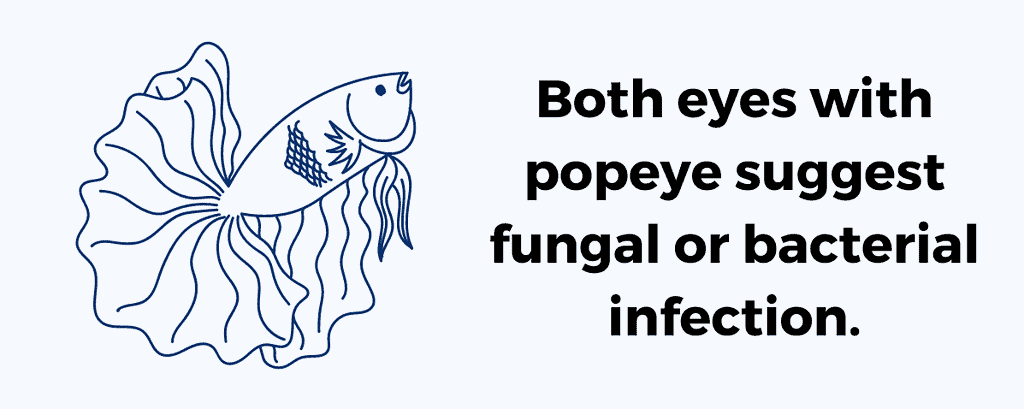
You may better understand the cause of popeye by looking at your betta’s symptoms.
If popeye only affects one of your betta’s eyes, it’s probably injured.
You may be dealing with a fungal or bacterial infection when popeye happens in both eyes.
Let’s look at some of the most common causes of popeye in bettas.
1. Bacterial and Fungal Infections
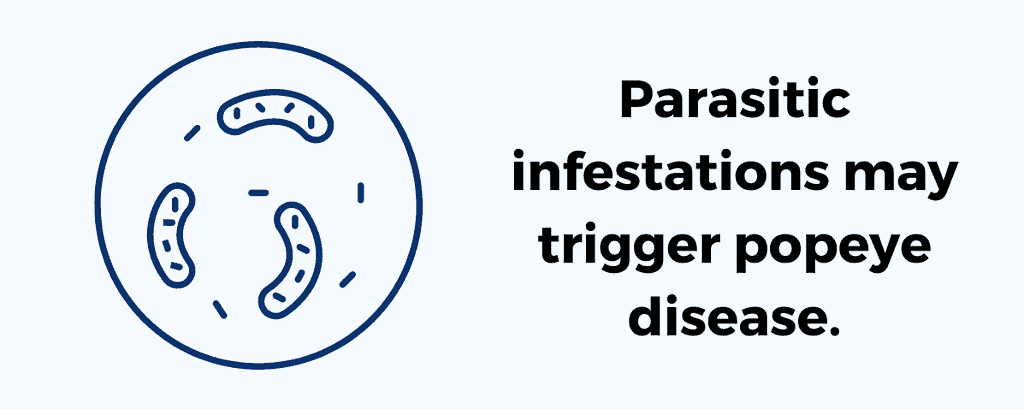
Bacterial and fungal infections are the most common causes of bilateral popeye in betta fish.
Parasitic infestations may also trigger the disease.
Popeye is sometimes the result of a more severe disease like tuberculosis.
Besides the eyes, these infections usually affect the betta’s entire body.
2. Physical Trauma

Physical injury is the primary cause of unilateral popeye in bettas.
Sharp edges on tank decorations or plastic plants can scratch your betta’s eye and cause swelling.
Attacks from aggressive tank mates may also cause eye trauma and betta popeye.
The eye may heal on its own over time, but always check for signs of infection.
3. Poor Water Quality
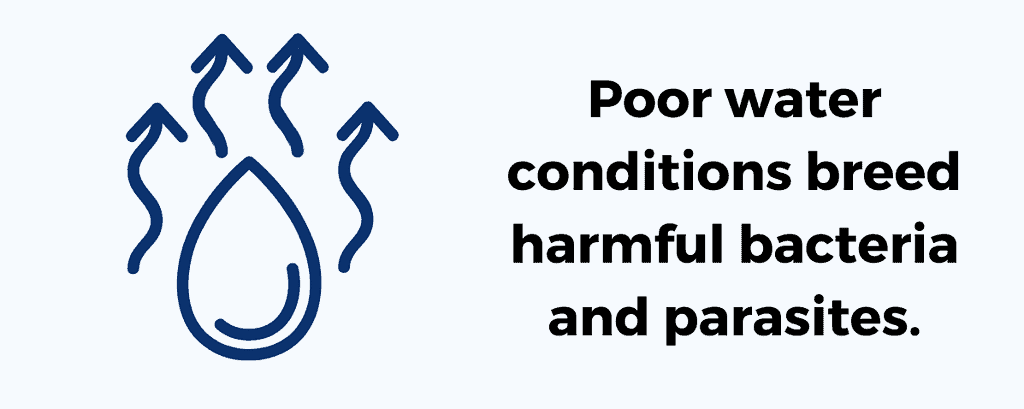
Poor water conditions are a breeding ground for harmful bacteria and parasite activity.
Popeye occurs when these parasites or bacteria infect your betta’s eyes.
Not cleaning your betta tank or doing weekly water changes causes elevated ammonia and nitrite levels.
Dirty tank water stresses your betta and lowers its immune system. This leaves your betta more prone to diseases like popeye.
4. Nutritional Deficiencies

Bettas need a varied, nutritional diet for strong immune system health.
A poor diet weakens a betta’s immune system. This makes the fish vulnerable to diseases and parasites.
Internal inflammation may occur when your betta cannot fight off these infections.
Internal inflammation and fluid build-up create pressure. When the pressure builds up behind the betta’s eyes, it causes popeye.
Common Symptoms of Popeye in Bettas

Understanding the symptoms of popeye in bettas helps you diagnose the disease.
The sooner you start treatment, the more likely your betta will fully recover.
If you delay treatment for popeye, your betta may have lifelong problems.
Regularly check your betta for any symptoms of popeye as listed below.
Swollen or Bulging Eyes
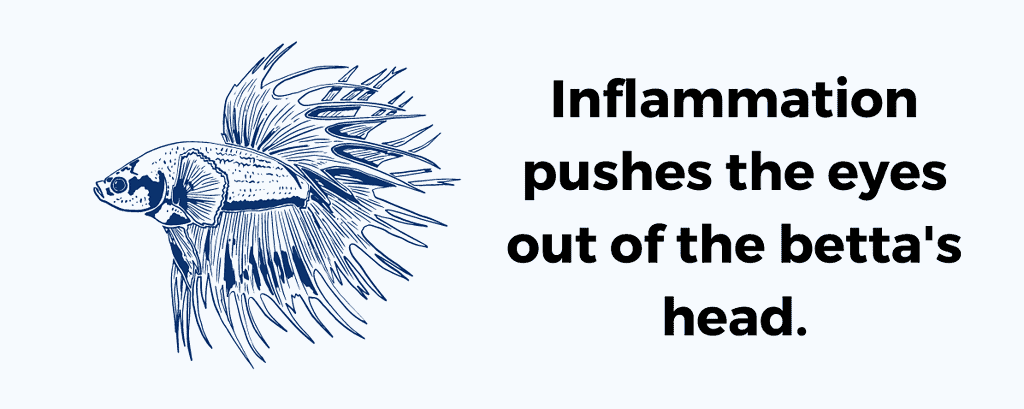
The most obvious symptom of popeye in bettas is swollen or bulging eyes.
This may appear in one or both eyes depending on the cause of popeye.
Inflammation from fluid build-up behind the eyes pushes them out of the betta’s head.
Bulging eyes happen in the advanced stages of popeye.
When you see this symptom, your betta needs treatment right away.
Cloudy Eyes
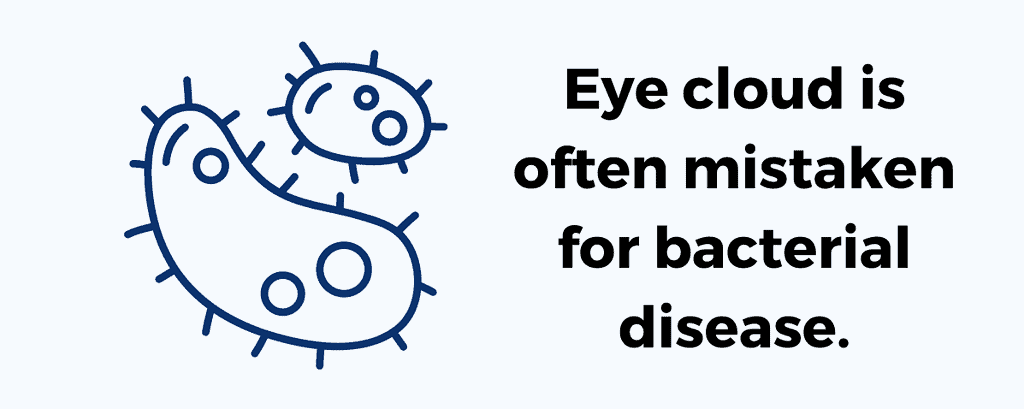
Cloudy or milky eyes in your betta mean the cornea has damage.
Many betta fish owners confuse this symptom for another bacterial disease known as eye cloud.
Eye cloud also occurs when a betta has cataracts. Bettas with eye clouds usually have a coating of mucus on their bodies.
This slime coat is part of a betta’s immune response to infection.
In popeye, the eyes have white splotches, a milky color, and protruding eyes.
For more details, check out our guide to cloudy eyes in betta fish and what it means.
Eye Discharge
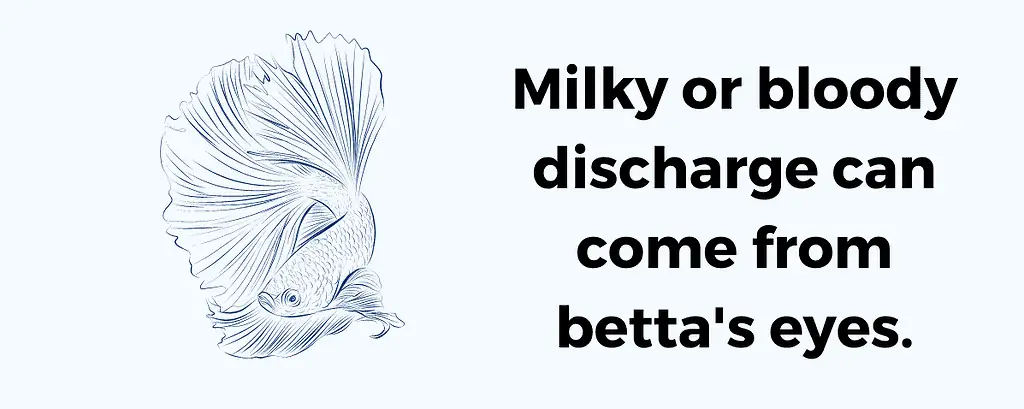
Sometimes, the fluid behind the eyes starts leaking out.
You may notice a milky or bloody discharge from your betta’s eyes.
This symptom is difficult to spot because the discharge is usually washed away in the tank water.
Changes in Eye Color

Besides cloudiness, your betta’s eyes may also have a bloodshot color.
Bloody eyes are most common in bettas with physical injuries.
This means blood vessels in the eye have ruptured.
White Rings Around the Eyes
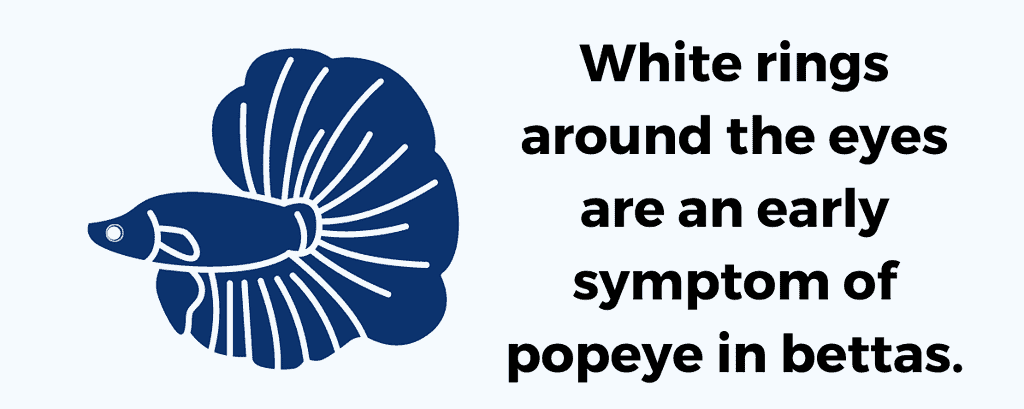
White rings around the eyes are an early symptom of popeye in bettas.
If you notice these white rings around your betta’s eyes, it is usually a matter of time before they start bulging or turning cloudy.
Treating your betta at the first sign of white-ringed eyes may prevent popeye from progressing.
Vision Loss or Blindness

Your betta may suffer vision loss or blindness with popeye.
If your betta has difficulty finding its food or bumps into decorative items, it likely has poor eyesight.
This symptom is usually temporary, and your betta regains eyesight after treatment.
In severe cases, the cornea ruptures, and the blindness becomes permanent.
Other Symptoms
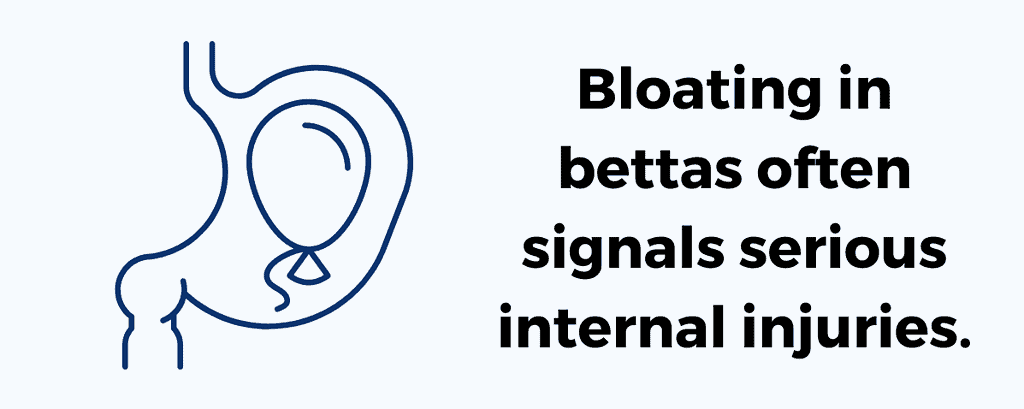
A betta with popeye also has other symptoms of illness, such as:
- Loss of appetite
- Fatigue
- Swimming in one spot
- Staying near the bottom of the tank
- Clamped fins
- Bloating
Bloating symptoms usually signal serious internal injuries. This is very common in fish tuberculosis.
Fish tuberculosis causes organ failure and has no cure.
If you think your betta has popeye, look for other illness symptoms when determining the cause.
What Are the Treatments for Popeye in Bettas?

The treatment for popeye in bettas depends on the cause of the disease.
Injuries may heal on their own and do not require quarantining your betta.
Popeye caused by bacterial diseases needs strong antibacterial medication.
Antifungal medications treat popeye caused by fungal infections.
If your betta is in a community tank, put your infected fish in a separate quarantine tank.
Doing this prevents the illness from spreading to the other tank mates. Certain medications also cause harm to aquatic plants.
Your betta’s eyes may not completely heal until a month after treatment.
Antibiotics

An antibiotic like ampicillin treats bacterial infections.
Ampicillin comes in capsule form. One capsule of ampicillin treats 10 gallons of water.
Do not treat your betta with ampicillin for more than 10 days. Overusing antibiotics creates antibiotic-resistant strains of bacteria.
Anti-Inflammatory Medication

Anti-inflammatory medications reduce the swelling and fluid retention caused by popeye.
This method of treatment does not kill bacteria or fungi.
It only helps with inflammation in the betta’s body due to infection.
Improved Water Conditions
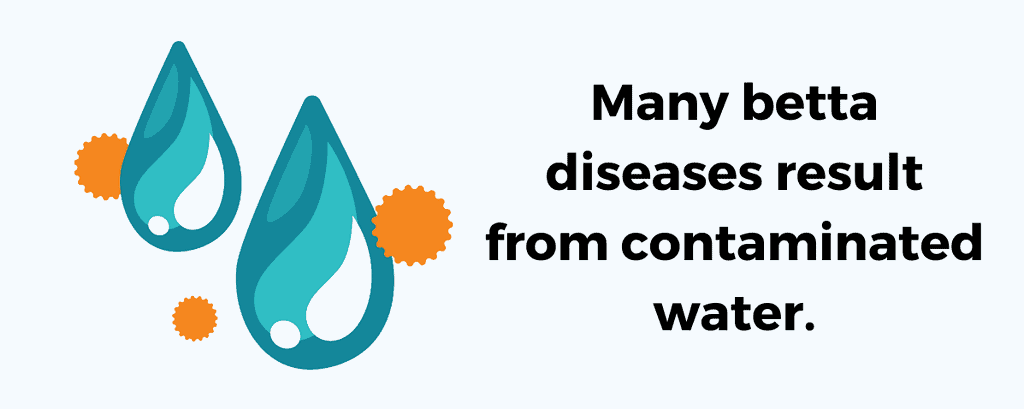
Poor water conditions harbor bacteria and other toxins. Many betta diseases are the result of contaminated water.
Dirty aquarium water causes stress in a betta, making the fish prone to infections like popeye.
Maintaining water quality gives your betta a clean environment for recovering from popeye.
Perform partial water changes every week. This prevents high levels of ammonia and harmful bacteria.
Invest in a quality water filter for protection against bacteria and toxins. The filter outflow must be gentle because bettas cannot swim well in strong currents.
Stable water temperatures also keep your betta from getting stressed. The ideal temperature range for bettas is between 78-80° degrees Fahrenheit (25.5-27° C).
Proper Nutrition

A nutritious diet keeps your betta’s immune system strong. This helps your betta fight popeye and make a full recovery.
Betta’s need a protein-rich diet of high-quality pellets and live foods.
Essential nutrients like vitamin A support eye health as well.
Aquarium Salt and Epsom Salt

Aquarium salt and Epsom salt are effective treatments for betta popeye.
Use aquarium salt if the popeye is due to injuries. This type of salt helps the injury heal faster.
Aquarium salt also promotes electrolytes in water and boosts a betta’s immune system.
Epsom salt is better for reducing inflammation and swelling caused by an infection.
If you have a planted tank or your betta has tank mates, I recommend using a separate quarantine tank for salt treatments.
Salts also build up in your water filtration system. Concentrated salt may kill plants and creates bad water conditions for your betta.
Using a separate aquarium for treatments avoids this salt buildup.
The correct dosage is one tablespoon of salt per gallon of water.
You may leave your betta in an Epsom salt bath for up to 10 minutes at a time. Aquarium salt is more potent, so limit the time to 5-8 minutes.
You may repeat the salt baths every day until the popeye improves.
Always check for signs of distress in your betta during salt baths. If your betta shows distress, remove it from the salt bath immediately.
Can Popeye in Bettas Be Prevented?
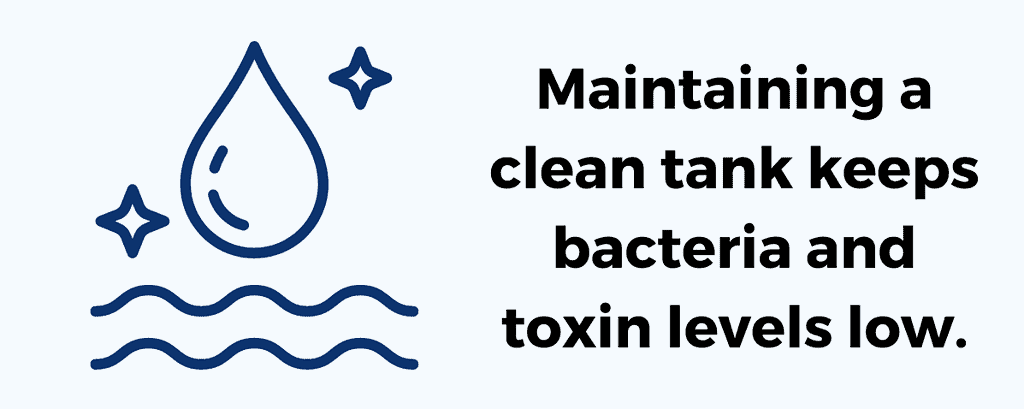
Popeye is a common disease in betta fish, but prevention is not difficult.
Following a few simple steps every week keeps your betta safe and healthy.
Maintaining Good Water Quality
Maintaining a clean tank prevents popeye by keeping bacteria and toxin levels low.
During weekly water changes, remove 20% of the water.
A gravel vacuum removes leftover food and waste from the substrate.
Leftover fish food and other waste products make the tank water too acidic. Acidic water causes health issues like popeye.
Remove algae from the sides of the tank with an algae scraper during water changes.
Use an aquarium test kit to determine pH, ammonia, and nitrite levels in the water.
Proper cleaning techniques ensure your betta has a healthy environment.
Providing Appropriate Living Conditions

Besides cleaning your betta tank, you must also pay attention to its decorative items.
Sharp objects cause injury to your betta and increase the risk of popeye. Prevent future injuries by ensuring no sharp edges or coarse textures in your betta tank.
Items like fake plants have sharp edges and may scratch your betta’s eyes.
Live plants create a more natural environment without putting your betta in danger.
If you choose artificial plants for your betta tank, be sure they are made of silk. Silk plants do not have dangerous sharp edges.
Check tank decorations for sharp edges as well.
Bettas need lots of hiding spots for extra security. Rounded objects like coconut caves and smooth rocks make excellent hiding places.
Take extra care when placing tank decorations. Your betta might injure itself if it gets stuck between the tank sides and a decoration.
Avoid loud noises and sudden movements around your betta tank. A startled betta may injure itself by swimming into an object in the tank.
Turn on the room lights for about 10 minutes before turning on the aquarium lights. This prevents startling your betta.
Avoiding Overcrowding

When setting up a community tank, aquarium size is essential.
I recommend a 20-gallon tank for housing your betta with other fish.
An overcrowded tank has a high bioload due to fish waste and leftover food. These waste products contaminate the water and create poor living conditions for your fish.
Overcrowding also increases the risk of fighting between your betta and other aggressive fish mates.
This fighting may result in an eye injury and lead to popeye in your betta. Remove aggressive fish from the tank immediately.
Isolate new fish in a quarantine tank for 4-6 weeks. This ensures the fish are healthy before placing them with your betta.
Proper Nutrition

Provide your betta with a varied diet of high-quality pellets and live or frozen foods.
This diet offers complete nutrition and keeps your betta’s immune system strong.
Ensure your betta’s diet includes vitamin A, which supports eye health.
Fast your betta at least one day per week. A day of fasting helps your betta’s digestion and prevents inflammation from constipation.
Are There Long-Term Effects of Popeye in Bettas?

Advanced stages of popeye may cause vision loss or blindness.
In most cases, vision loss is temporary, and your betta regains its eyesight after recovering from popeye.
But sometimes vision loss or blindness is permanent due to an eye rupture. Your betta will eventually adapt to the vision loss.
When popeye affects one eye due to injury, the affected eye may become infected. The eye rots and must be removed by a veterinarian.
Is There a Cure for Popeye in Bettas?
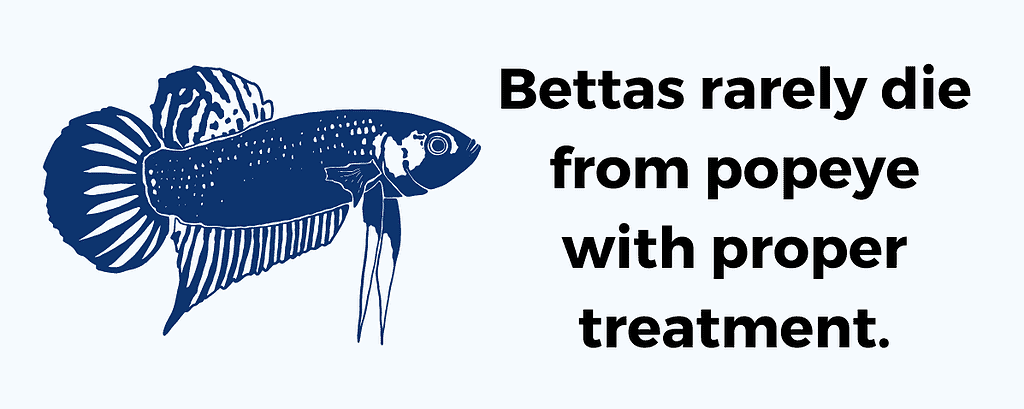
Popeye is cured easily when treated at the first signs of the disease.
In the advanced stages of popeye, your betta might lose an eye.
Bettas rarely die from popeye with proper treatment unless the disease is caused by tuberculosis.
Is Popeye in Bettas Contagious?
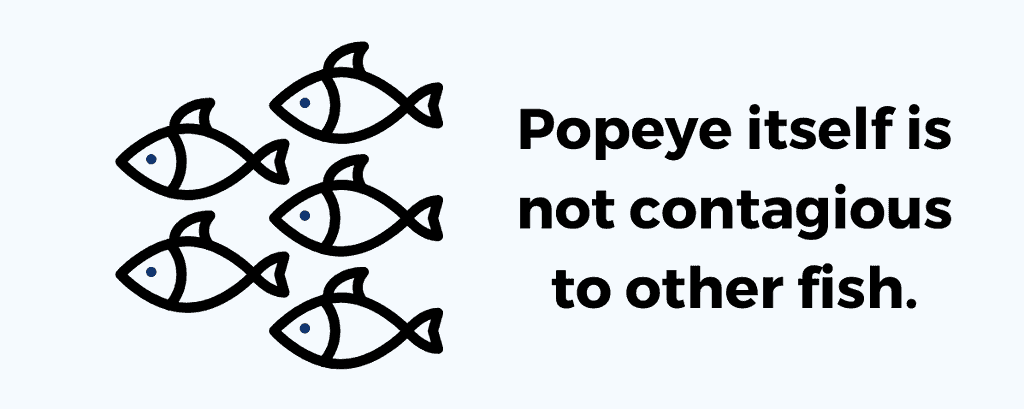
Popeye itself is not contagious to other fish.
But, if a bacterial disease causes popeye, it may spread to other fish in the tank.
Take extra precautions by removing sick fish from the main tank at the first symptoms of the disease.
Place the sick fish in a hospital tank until it has been treated with medications.
Can Popeye in Bettas Be Bred Out?

Some species, like the Black Moor Goldfish, are purposely bred for bulging eyes as a desirable trait. The bulging eyes are a part of the fish’s genetics.
Popeye in bettas is a disease, not a genetic trait. There is currently no way of breeding bettas resistant to popeye.
But, poor breeding practices create bettas with weakened immune systems. This makes them more prone to diseases like popeye.
Some species of betta are more prone to health issues than others. This happens because of selective breeding for certain traits and inbreeding.
For example, bettas with the dragon scale trait have a high risk of developing scales over their eyes.
Marbled bettas often develop tumors due to their constant genetic mutation.
Veil-tail bettas have the lowest risk of being born with genetic abnormalities. Many people consider veil tails undesirable, so they have a larger gene pool.
How Does Popeye Affect a Betta’s Quality of Life?

Like many fish diseases, Popeye is painful and stressful for a betta. Seek help right away to relieve your betta of symptoms.
Once your betta fully recovers from popeye, its life returns to normal.
Even if your betta loses an eye or suffers from permanent blindness, the fish eventually adapts to its new way of life.
Don’t Ignore Popeye in Your Betta!
Popeye is not a deadly disease, and most bettas fully recover.
Treating popeye in its early stages is crucial in preventing permanent vision loss.
Recognizing the symptoms of popeye in your betta allows for prompt treatment.
Maintaining a clean and healthy environment for your betta prevents popeye from ever happening to your fish.
Always seek veterinary care if you are unsure of what is wrong with your betta.
Check out our full list of common betta sicknesses to keep your bettas healthy their whole lives.


